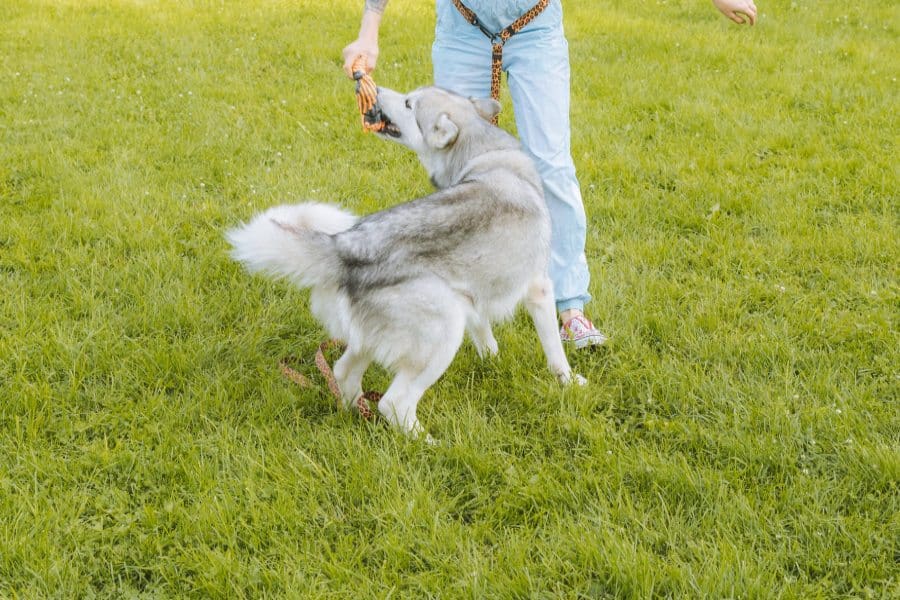Huskies, known for their striking appearance and vibrant energy, are a breed that captivates the hearts of dog lovers worldwide. However, their spirited nature often challenges owners aiming to nurture a serene and well-behaved companion. This article delves into practical strategies for training your Husky to embrace calmness, blending the breed’s unique characteristics with proven training methods. From creating a soothing environment to implementing behavioral modification techniques, we will explore a range of approaches that cater to the Husky’s intelligence and high energy levels. Whether you’re a seasoned Husky owner or new to the breed, these insights will guide you toward fostering a harmonious and peaceful relationship with your spirited canine friend.
How To Train A Husky To Be Calm?
Training a Husky to be calm requires patience, consistency, and an understanding of the breed’s unique traits. Huskies are known for their high energy and intelligence, so the training approach should be tailored to these characteristics. Here are some effective strategies:
Regular Exercise: Huskies need ample physical activity to burn off their energy. Ensure your Husky gets plenty of exercise every day. This can include long walks, runs, hikes, and playtime. A tired Husky is typically a calmer Husky.
Mental Stimulation: Just as important as physical exercise, mental stimulation helps keep your Husky’s mind engaged and calm. Use puzzle toys, obedience training, and interactive games that challenge their intelligence.
Consistent Training: Start training your Husky from an early age. Use positive reinforcement techniques such as treats and praise to encourage calm behavior. Teach basic commands like ‘sit,’ ‘stay,’ and ‘down,’ which can help in situations where you need your Husky to remain calm.
Socialization: Expose your Husky to different people, animals, and environments from a young age. Socialization helps prevent anxiety and over-excitement in new situations, leading to a calmer demeanor.
Behavioral Training: If your Husky shows signs of hyperactivity or anxiety, consider more advanced behavioral training. Techniques like desensitization and counterconditioning can be effective for managing specific issues.
Diet and Nutrition: A well-balanced diet is crucial for your Husky’s overall health and behavior. Consult a vet to ensure your Husky gets the proper nutrients to maintain a balanced energy level.
Professional Help: If you’re struggling to manage your Husky’s behavior, don’t hesitate to seek help from a professional dog trainer or behaviorist. They can provide personalized guidance and strategies.
Importance Of A Consistent And Peaceful Home Environment.
The importance of a consistent and peaceful home environment in the training and overall well-being of a Husky, or any dog, cannot be overstated. Such an environment is crucial in shaping a dog’s behavior and temperament. Here are some key aspects highlighting its importance:
Dogs, like humans, can be sensitive to stress. A chaotic or noisy environment can increase anxiety levels in dogs, leading to behavioral issues such as excessive barking, aggression, or destructiveness. A peaceful environment helps keep your Husky calm and relaxed.
Consistency in the home environment gives your Husky a sense of predictability and security. Dogs thrive on routine, and a stable environment where they know what to expect (regarding meal times, walks, and rest periods) helps them feel secure and content.
A consistent environment aids in training, minimizing distractions and conflicting cues. When a Husky knows what to expect and receives consistent responses from its owners, it can learn and adhere to rules and commands more effectively.
For a Husky to learn effectively and be calm, it needs an environment to focus and understand what is expected. A peaceful home allows for more transparent communication between you and your dog.
A calm and consistent environment fosters a stronger bond between you and your Husky. It creates a space for positive interactions, such as gentle play and cuddling, strengthening your relationship.
Just like in humans, dogs’ mental health is closely linked to their physical health. A stress-free environment contributes to overall better health, potentially reducing the risk of stress-related health issues.
Dogs raised in peaceful environments are often better socialized and react more calmly to external stimuli. This is particularly important for Huskies, who can be exuberant and sometimes overwhelming in social situations.
Recommended Exercise Routines For Huskies
For Huskies, a breed known for their remarkable endurance and energy, an appropriate exercise routine is essential for their physical and mental well-being. Here are some recommended exercise routines detailed in a structured manner:
Daily Walks:
Begin with at least two daily walks, each lasting 30 to 60 minutes. These walks should be brisk to expend energy adequately. Depending on your Husky’s needs and stamina, you can increase the duration or intensity.
Running and Jogging:
Huskies make excellent running partners due to their endurance. Incorporate running or jogging sessions a few times a week. Start with shorter distances and gradually increase as your Husky builds more stamina.
Hiking Adventures:
Taking your Husky on hikes, especially in natural, stimulating environments, can be incredibly beneficial. These outings provide both physical exercise and mental stimulation as they explore different terrains and scents.
Interactive Play:
Engage in interactive play sessions such as fetch, tug-of-war, or Frisbee. These activities not only help in burning energy but also strengthen the bond between you and your Husky.
Agility Training:
Set up an introductory agility course in your yard or join an agility club. Navigating through obstacles like tunnels, jumps, and weave poles provides excellent mental and physical exercise.
Dog Sports:
Dog sports like sledding, skijoring, or bickering are particularly suitable for Huskies. These activities cater to their natural pulling instincts and provide vigorous exercise.
Swimming:
If your Husky enjoys water, swimming can be a great exercise, especially in warmer weather. It’s a low-impact activity that’s easy on the joints while providing a good workout.
Puzzle Toys and Games:
On days when outdoor activity is limited, use puzzle toys and indoor games to provide mental stimulation. These can include hide-and-seek with treats or toys that require problem-solving.
Seasonal Activities:
Depending on your location and the season, incorporate activities like snowshoeing or cross-country skiing with your Husky in winter. In summer, activities like beach visits or playing in a dog-friendly pool can be enjoyable.
Tips For Creating A Husky-Friendly Space
Creating a Husky-friendly space in your home is essential for the well-being and happiness of your furry companion. Huskies are energetic, intelligent, and curious dogs, so their environment should cater to these traits. Here are some tips to create a space that your Husky will love:
- Secure Outdoor Space: Huskies are known for their love of the outdoors and their ability to escape. Ensure that your yard is securely fenced with no gaps or weak spots. The fence should be high enough to prevent jumping over and possibly buried at the base to prevent digging under.
- Shelter and Shade: Provide a comfortable, sheltered area outside where your Husky can relax; critical to protect them from harsh weather conditions like hot sun, rain, or snow.
- Indoor Comfort: Provide a dedicated space for your Husky inside the house. A comfortable bed in a quiet corner can be a perfect resting place. Huskies often prefer more excellent spots, so make sure their bed is away from direct heat sources.
- Chew Toys and Puzzle Feeders: Huskies love to chew and are intelligent dogs that need mental stimulation. Provide a variety of durable chew toys, puzzle feeders, and interactive toys to keep them occupied and mentally engaged.
- Exercise Area: If you have enough space, create an area where your Husky can exercise freely, like a running or play area. This can be part of the yard or a room in the house where they can move around without restrictions.
- Safe Havens: Huskies can be sensitive to noise and may need a quiet place to retreat. A crate or a particular area with their bedding can be a haven for them during noisy events or when they need solitude.
- Accessible Water: Huskies can dehydrate quickly, especially after exercise or in hot weather. Ensure they have constant access to fresh, clean water indoors and outdoors.
- Grooming Station: Huskies have thick coats that require regular grooming. Set up a grooming station with brushes, combs, and other tools to manage shedding and keep their coat in good condition.
- Temperature Control: Since Huskies are bred for cold climates, they can overheat in warmer temperatures. Ensure that your home is well-ventilated and cool. Consider using fans or air conditioning in hot weather.
- Proofing Your Space: Huskies are curious and can be mischievous. Proof your space by securing cabinets, removing toxic plants or substances, and ensuring that small objects they might chew on or swallow are out of reach.
Conclusion
Training a Husky to be calm is a multifaceted approach that requires understanding the breed’s unique characteristics, providing ample exercise and mental stimulation, and fostering a consistent and peaceful home environment. By incorporating regular physical activities, engaging in mental enrichment, and ensuring a safe and Husky-friendly space, owners can significantly contribute to their Husky’s well-being. Patience, consistency, and positive reinforcement are essential in this journey. Remember, the goal is to have a well-behaved pet and develop a deep and rewarding bond with your Husky. You can enjoy the joys and adventures of having a happy, healthy, and calm Husky companion with the right approach and dedication.







Leave a Reply